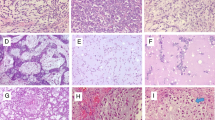Abstract
Ezrin is a cytoskeleton linker protein that is actively involved in the metastatic process of cancer cells. We have recently reported that ezrin expression in conventional osteosarcoma was an independent prognostic factor for event-free survival and overall survival. In this work, ezrin expression was found in all histological subtypes. Especially cartilaginous areas in chondroblastic osteosarcomas were immunopositive for ezrin. We wanted to know if ezrin could be a useful diagnostic marker in bone pathology. We have searched for ezrin expression in 208 cartilaginous tumours by immunohistochemistry and in 16 chondroblastic osteosarcomas. All conventional chondrosarcomas, whatever their grade, were negative, while ten of 16 chondroblastic osteosarcomas were positive. In contrast, dedifferentiated (five of 14) and mesenchymal chondrosarcomas (five of ten) showed ezrin positivity. Some chondroblastomas and more rarely chondromyxoid fibromas also exhibited ezrin expression. These data suggest that ezrin is a useful immunohistochemical marker for differential diagnosis between chondroblastic osteosarcomas and conventional chondrosarcomas with a specificity of 100%. Ezrin expression in dedifferentiated and mesenchymal chondrosarcomas which are aggressive neoplasms resistant to conventional treatment means that ezrin could be a therapeutic target. Ezrin expression in chondroblastomas is more intriguing and requires further study to assess prognostic value.


Similar content being viewed by others
References
Khanna C, Khan J, Nguyen P et al (2001) Metastasis-associated differences in gene expression in a murine model of osteosarcoma. Cancer Res 61:3750–3759
Krishnan K, Bruce B, Hewitt S et al (2006) Ezrin mediates growth and survival in Ewing’s sarcoma through the AKT/mTOR, but not the MAPK, signaling pathway. Clin Exp Metastasis 23:227–236
Weng WH, Ahlen J, Astrom K et al (2005) Prognostic impact of immunohistochemical expression of ezrin in highly malignant soft tissue sarcomas. Clin Cancer Res 11:6198–6204
Mangeat P, Roy C, Martin M (1999) ERM proteins in cell adhesion and membrane dynamics. Trends Cell Biol 9:187–192
Vaheri A, Carpen O, Heiska L et al (1997) The ezrin protein family: membrane–cytoskeleton interactions and disease associations. Curr Opin Cell Biol 9:659–666
Khanna C, Wan X, Bose S et al (2004) The membrane–cytoskeleton linker ezrin is necessary for osteosarcoma metastasis. Nat Med 10:182–186
Park HR, Jung WW, Bacchini P et al (2006) Ezrin in osteosarcoma: comparison between conventional high-grade and central low-grade osteosarcoma. Pathol Res Pract 202:509–515
Salas S, Bartoli C, Deville JL et al (2007) Ezrin and alpha-smooth muscle actin are immunohistochemical prognostic markers in conventional osteosarcomas. Virchows Arch 451:999–1007
Ogino W, Takeshima Y, Mori T et al (2007) High level of ezrin mRNA expression in an osteosarcoma biopsy sample with lung metastasis. J Pediatr Hematol Oncol 29:435–439
Ferrari S, Zanella L, Alberghini M et al (2008) Prognostic significance of immunohistochemical expression of ezrin in non-metastatic high-grade osteosarcoma. Pediatr Blood Cancer 50:752–756
Dickey ID, Rose PS, Fuchs B et al (2004) Dedifferentiated chondrosarcoma: the role of chemotherapy with updated outcomes. J Bone Jt Surg 86-A:2412–2418
Staals EL, Bacchini P, Bertoni F (2006) Dedifferentiated central chondrosarcoma. Cancer 106:2682–2691
Brown RE (2004) Morphoproteomic portrait of the mTOR pathway in mesenchymal chondrosarcoma. Ann Clin Lab Sci 34:397–399
Wan X, Mendoza A, Khanna C et al (2005) Rapamycin inhibits ezrin-mediated metastatic behavior in a murine model of osteosarcoma. Cancer Res 65:2406–2411
Chow LTC, Lin J, Kumta SM et al (1996) Chondromyxoid fibroma-like osteosarcoma: a distinct variant of low-grade osteosarcoma. Histopathology 29:429–436
Klein MJ, Siegal GP (2006) Osteosarcoma. Anatomic and histologic variants. Am J Clin Pathol 125:555–581
Schajowicz F, de Prospero JD, Cosentino E (1990) Case report 641: chondroblastoma-like osteosarcoma. Skelet Radiol 19:603–603
Soder S, Oliveira AM, Inwards CY et al (2006) Type II collagen, but not aggrecan expression, distinguishes clear cell chondrosarcoma and chondroblastoma. Pathology 38:35–38
Aigner T, Loos S, Inwards C et al (1999) Chondroblastoma is an osteoid-forming, but not cartilage-forming neoplasm. J Pathol 189:463–469
van der Geest IC, van Noort MP, Schreuder HW et al (2007) The cryosurgical treatment of chondroblastoma of bone: long-term oncologic and functional results. J Surg Oncol 96:230–234
Hassan S, Ferrario C, Mamo A et al (2008) Tissue microarrays: emerging standard for biomarker validation. Curr Opin Biotechnol 19:19–25
Acknowledgments
We are grateful to P. Morando and Arlette Calisti for technical assistance. This work was supported by Institutional grants, by the “Appel d’offre APHM 2005” and by the Philippe Daher foundation.
Disclosure of conflict of interest
We declare that we have no conflict of interest.
Author information
Authors and Affiliations
Corresponding author
Rights and permissions
About this article
Cite this article
Salas, S., de Pinieux, G., Gomez-Brouchet, A. et al. Ezrin immunohistochemical expression in cartilaginous tumours: a useful tool for differential diagnosis between chondroblastic osteosarcoma and chondrosarcoma. Virchows Arch 454, 81–87 (2009). https://doi.org/10.1007/s00428-008-0692-8
Received:
Revised:
Accepted:
Published:
Issue Date:
DOI: https://doi.org/10.1007/s00428-008-0692-8




